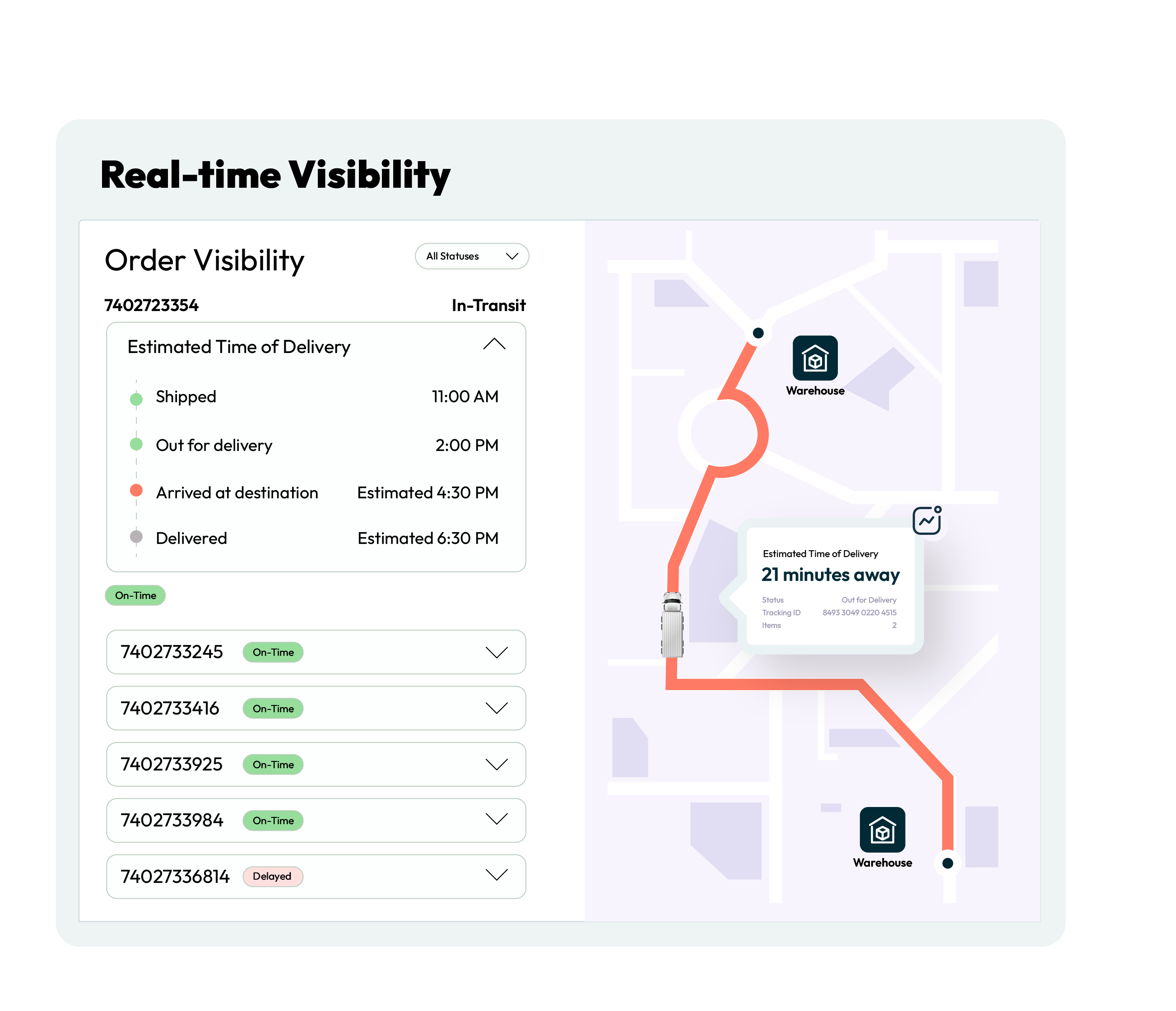- Vehicle Routing
How Vehicle Routing Software Can Help Businesses Control Costs
Table of Contents
- Understanding the Key Drivers of Inefficient Routing
- From Maps to Intelligence: The Evolution of Vehicle Routing Software
- How Vehicle Routing Drives Cost-Efficiency at Every Layer
- Why Businesses Are Turning to FarEye
- What to Look for in Routing Software: A Dispatcher’s Checklist
- Smarter Routing Isn’t Just an Upgrade; It’s a Key Competitive Edge

In 2024 alone, transportation and logistics costs reached a staggering $2.3 trillion in the United States, equivalent to 8.7% of the national GDP. A significant portion of these expenses stemmed not from long-haul movements or inventory warehousing but from the last leg of delivery, where unpredictability, fuel prices, and service failures converge. In fact, last-mile delivery can account for over 53% of total shipping costs, according to research.
For dispatchers and logistics managers managing thousands of orders each day, this is not just a stat; it’s a daily operational challenge. Missed time windows, poor stop sequencing, underutilised fleets, and idle miles slowly compound into one expensive truth: unoptimised delivery is a silent cost leak.
That’s why today, vehicle routing has evolved from a basic scheduling function to a mission-critical lever for cost efficiency, customer satisfaction, and competitive advantage. And at the centre of this shift? Intelligent, AI-powered vehicle routing software.

Understanding the Key Drivers of Inefficient Routing
Vehicle routing, in essence, is about more than just plotting points on a map. At scale, it becomes a highly complex puzzle. A dispatcher must consider:
- Traffic congestion
- Driver availability and legal limits
- Fleet type and capacity
- Service time at each stop
- Delivery time windows
- Road restrictions
- Route dependencies
When managed manually, even the best team quickly hits the ceiling. Poor routing choices lead to:
- Excess fuel consumption
- Extended vehicle usage and maintenance
- Overworked drivers and legal risk
- SLA breaches and customer churn
- Inefficient load distribution
It’s a compounding problem, and it demands a smarter solution.
From Maps to Intelligence: The Evolution of Vehicle Routing Software
Traditional route planning focused on fixed parameters. But today’s routing software is built for dynamic, real-world logistics. It’s designed to adjust in real-time, predict demand patterns, and learn from every completed route. Modern vehicle routing software uses a combination of:
- Artificial Intelligence (AI) to simulate and compare routing scenarios
- Machine Learning (ML) to improve accuracy over time
- Geospatial mapping for real-time traffic and road conditions
- Automation engines for dispatch, load balancing, and ETA updates
- Historic data and patterns that offer key learnings
This convergence of data, intelligence, and automation has shifted routing from tactical to strategic.
How Vehicle Routing Drives Cost-Efficiency at Every Layer
Here’s how smart routing cuts through inefficiencies at every level of the delivery operation:
- Lower Fuel Costs
Route optimization ensures vehicles take the shortest and fastest path, reducing idle time and fuel usage. When software accounts for traffic, weather, and stop sequencing, even minor improvements in routing can slash fuel expenses by 10%–20% monthly. - Higher Vehicle and Driver Productivity
When drivers make more deliveries in shorter time windows, operational capacity rises without expanding fleet size. Smart routing software balances delivery loads across drivers while respecting compliance limits (e.g., Hours of Service rules in the US). - Reduced Empty Miles and Backhauls
Advanced routing solutions support co-mingling of loads and dynamic rerouting, especially useful for businesses managing reverse logistics or multi-client drop-offs. This improves overall vehicle utilisation and minimises empty runs. - Improved On-Time Delivery Performance
Accurate ETAs, AI-based dispatching, and proactive alerts improve SLA adherence. Customers receive their orders on time, and businesses avoid penalties or compensation costs. - Data-Driven Operational Insights
Modern routing platforms provide performance analytics dashboards, offering granular visibility into:
- Route efficiency
- Order-to-delivery time
- Stop-level delays
- Driver productivity
- Missed time windows
These insights help logistics teams continuously refine operations and reduce long-term cost drivers.
Why Businesses Are Turning to FarEye
Among the few platforms equipped to handle this complexity at scale, FarEye stands out for its AI-powered vehicle routing software purpose-built for enterprise logistics.
FarEye’s solution is trusted across industries, from courier giants and food delivery networks to pharma distributors and furniture retailers, because it focuses on real-world routing at operational scale.
Here’s how FarEye transforms cost-intensive routing into a competitive asset:
- AI-Based Routing Engine
FarEye uses machine learning algorithms to continuously improve delivery accuracy and routing efficiency. Its system considers over 100 constraints, from driver skills and service time predictions to weather, vehicle type, and traffic data.
For example, FarEye has been shown to reduce load planning time from 5 hours to just 30 minutes, while improving route efficiency by 14% and cutting driving hours by 10%. - Dynamic Re-Routing and SLA Management
Real-time traffic, last-minute cancellations, or last-minute delivery schedule changes? FarEye dynamically adjusts routes while maintaining SLA commitments, ensuring no delivery is unnecessarily delayed or duplicated. - Smart Load & Territory Planning
Using AI to ingest 1 year’s worth of operational data, FarEye’s territory planner breaks regions into hyper-accurate zones. This allows businesses to distribute work equally and reduce driver overload. - Rate-Based Routing & Hybrid Models
FarEye supports flexible delivery models, whether it's an in-house fleet, gig workers, or outsourced partners. It evaluates cost per route, time per delivery, and even EV charging stops to recommend the most cost-effective delivery allocation.
What to Look for in Routing Software: A Dispatcher’s Checklist
If you're evaluating routing solutions, make sure they offer:
- Real-Time Route Optimization
- Multi-Stop and Territory Routing with auto-merge and zone logic
- Mobile Integration for drivers (turn-by-turn, updates, proof of delivery)
- AI/ML Capabilities for dynamic SLA, weather, and cost adjustments
- Detailed Analytics Dashboards for route efficiency and compliance
- Scalability for spikes in demand and multi-region operations
FarEye offers all this and more, making it an ideal fit for enterprises managing high-volume, time-sensitive, and cost-critical logistics operations.
Smarter Routing Isn’t Just an Upgrade; It’s a Key Competitive Edge
Rising costs, driver shortages, and customer expectations are non-negotiable realities in today’s logistics environment. The difference between scaling profitably and sinking into inefficiencies often lies in how well you route your fleet.
Vehicle routing is a frontline differentiator. With FarEye’s AI-powered platforms, businesses are not just reacting to logistics challenges; they’re getting ahead of them.
By embracing intelligent routing, enterprises unlock faster deliveries, lower costs, better visibility, and more resilient operations.
Because in modern logistics, efficiency isn’t a metric. It’s a mandate.
Source:
https://cscmp.org/CSCMP/CSCMP/Educate/State_of_Logistics_Report.aspx
https://www.globaltrademag.com/last-mile-delivery-challenges-and-innovative-solutions/

Komal Puri is a seasoned professional in the logistics and supply chain industry. As the AVP of Marketing and a subject matter expert at FarEye, she has been instrumental in shaping the industry narrative for the past decade. Her expertise and insights have earned her numerous awards and recognition. Komal’s writings reflect her deep understanding of the industry, offering valuable insights and thought leadership.
Let's Talk to Our Experts and Optimize Your Deliveries Today!
An expert from our team will reach out within 24 hours


